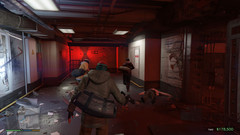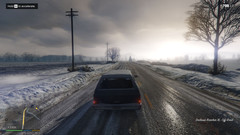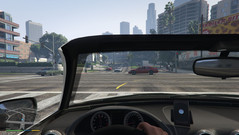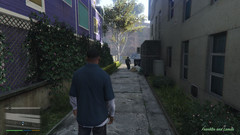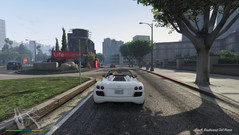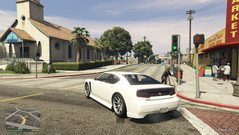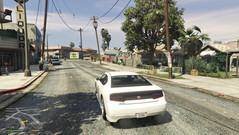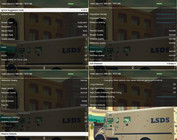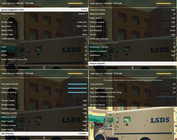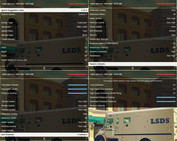GTA V Benchmarked
Engine, Benchmarks, and Results
For the original German article, see here.
GTA V is based on the RAGE engine (not to be confused with the Ego shooter from id Software), which has been tweaked with additional engines like Euphoria (character animation) and Bullet (physics simulation). The end result is a spectacular PC experience which offers convincing textures, shadows, lighting and vegetation at high to max settings.
Although now and then objects may appear unclear during fast rides (cars, planes, etc.), this problem of rendering shadows and quality settings exists in almost every Open World game. In a direct comparison to Watch Dogs, GTA V performs better. The lighting is more realistic despite lower hardware requirements.
If you were expecting the PC port of GTA V to be a huge disaster, you can rest easy now. During our benchmarks we almost never encountered serious bugs or crashes. However, we did encounter some issues starting the game on Nvidia laptops. Although the latest GeForce driver, the ForceWare 350.12, was installed, the systems, equipped with Optimus, did not want to start up the Rockstar Social Club, preventing the game from launching. Google contained the answer: open the device manager, disable the Nvidia adapter for a little while, start GTA V and as soon as the Social Club starts, turn on the graphics card.
In general, our experience with the game was not smooth. At around 60 GB (~3 hours download with VDSL 50; the shop version includes 7 DVDs!), GTA V sets a new record (negative) for loading times (game start, save games, etc.) and the integrated benchmark only works if both Intro missions have been absolved.
The system requirements are not too bad. Yes, GTA V would like a quad-core CPU (compare the performance of the Schenker M504 [GTX 850M + dual-core] and the M503 [GT 750M + quad-core]), but halfway potent dual-core processors, like the Core i5-4200M, can suffice. The same applies to the VRAM. Although the requirements rise to 2 or 3 GB with higher settings (similar to Wolfenstein: The New Order and Shadow of Mordor), the game remains playable, as we saw from the GTX 960M with 2 GB VRAM (quite fluid at high settings).
In most scenes, the graphics card is the limiting factor. However, at low or medium settings, the processor can be the bottleneck (as seen from our desktop PCs which use a Core i7-3770K and a Core i7-4790K and the Schenker W504, whose Core i7-4700MQ is the limiting factor [starting at the GTX 860M]).
The graphics menu deserves praise for the surprising number of options it contains. If you have high-end gear, you can activate MSAA- or TXAA smoothing. The latter can only be found on Nvidia models. Great: if you deactivate vertical synchronization, it is possible to go above 60 fps on the PC version. As there are no global presets, we have to use manually configured settings files which have to then be placed at the appropriate path: C:\Users\xyz\Documents\Rockstar Games\GTA V.
At this path, the user will find a folder named "Benchmarks," which contains recorded measurements. We do not understand why the files have no overall score and "only" note the minimum, average and maximum frames possible in each of the five scenes. We chose to use the results of the last sequence (pass 4). Due to the short runtime, the first four tests (pass 0-3 = panorama shots with day/night change) are not very reliable. The 2-minute final scene with the fighter jet and car chase is more reliable due to it being closer to actual gameplay.
We still would not consider the benchmark perfect as the minimum frames fluctuate heavily in pass 4, which is probably due to bugs. Furthermore, the average fps can fluctuate during each test due to the randomly simulated traffic (difference of a few fps).
If you disregard the somewhat awkward control with a mouse and a keyboard, the PC version of GTA V is technically okay. In no way is it like the stutter disaster which is GTA IV. The hardware requirements are appropriate, with the exception of a few settings. The same cannot be said of many other games, like Assassin's Creed Unity. Most systems will have some graphical errors (for example, the Radeon R9 280X @Ultra) and sadly the graphics menu does not offer descriptions for the options, which we hope will be remedied.
Back to the benchmark: according to our benchmarks, the game requires at least an Iris Pro 5200 at low settings and a resolution of 1024x768 pixels. Weaker Intel chips, like the successful Core i models, the HD Graphics 3000, 4000 and 4600 are not appropriate to run GTA V (the benchmarks should run at above 40 fps). Middle-class GPUs, starting at the GeForce GT 740M, are suited for normal settings and a resolution of 1366x768 pixels.
If you want to run the game at the FHD resolution with high details and 2x MSAA, then you need a high-end graphics card, like the GeForce GTX 960M. Sadly, no notebook GPU can run the game fluidly with max settings and all options turned on. In the Ultra test, even the GeForce GTX 980M suffered at a mere 36 fps. For such high settings, you require cutting-edge desktop hardware (GTX 980 @45 fps).
Tip: Asus will provide us with a 4K display shortly, which will help us add some more information to our gaming benchmarks. How interested are you in 4K? Please write to us in the forum below.
| GTA V | |
| 3840x2160 High/On (Advanced Graphics Off) AA:FX AF:8x 1920x1080 Highest Settings possible AA:4xMSAA + FX AF:16x 1920x1080 High/On (Advanced Graphics Off) AA:2xMSAA + FX AF:8x 1366x768 Normal/Off AF:4x 1024x768 Lowest Settings possible | |
| NVIDIA GeForce GTX 980, 3770K | |
| AMD Radeon R9 290X, 4790K | |
| NVIDIA GeForce GTX 980M, 4700MQ | |
| AMD Radeon R9 280X, 3770K | |
| NVIDIA GeForce GTX 970M, 4700MQ | |
| NVIDIA GeForce GTX 880M, 4700MQ | |
| NVIDIA GeForce GTX 870M, 4700MQ | |
| NVIDIA GeForce GTX 960M, 4720HQ | |
| NVIDIA GeForce GTX 860M, 4700MQ | |
| NVIDIA GeForce GTX 850M, 4340M | |
| NVIDIA GeForce GT 750M, 4702MQ | |
| AMD Radeon R7 512 Cores (Kaveri Desktop), A10-7850K | |
| NVIDIA GeForce GT 640M, 2637M | |
| NVIDIA GeForce GT 740M, 4200M | |
| NVIDIA GeForce GT 630M, 3720QM | |
| Intel Iris Pro Graphics 5200, 4750HQ | |
| NVIDIA GeForce GT 720M, 4200M | |
| Intel HD Graphics 4600, 4700MQ | |
| Intel HD Graphics 3000, 2637M | |
Four of our test models are provided by Schenker Technologies (mysn.de):
- W504 (Core i7-4700MQ, 8 GB DDR3, GeForce GTX 860M, GTX 870M, GTX 880M, GTX 970M, GTX 980M, Win 7)
- A505 (Core i7-4720HQ, 8 GB DDR3, GeForce GTX 960M, Win 8.1)
- M504 (Core i5-4340M, 8 GB DDR3, GeForce GTX 850M, Win 7)
- M503 (Core i7-4702MQ, 8 GB DDR3, GeForce GT 750M, Win 7)
Three of our test models came from Nvidia:
- HP Envy 15-j011sg (Core i5-4200M, 12 GB DDR3, GeForce GT 740M)
- MSI CX61-i572M281BW7 (Core i5-4200M, 8 GB DDR3, GeForce GT 720M)
- Acer Aspire Timeline Ultra M3-581TG (Core i7-2637M, 4GB DDR3, GeForce GT 640M)
Intel added:
- Schenker S413 (Core i7-4750HQ, 8 GB DDR3, Iris Pro Graphics 5200)
The desktop PCs contain CPUs/APUs from Intel and AMD, SSDs from Micron, Intel and Samsung, motherboards from Intel and Asus and graphics cards from Nvidia and AMD.
GPU drivers used: Nvidia 350.12, AMD 15.4 Beta, Intel 10.18.10.14.4156
Overview
The first mission of GTA 5 running on a Acer Aspire M3-581TG (Core i7-2637M Dual-Core, GeForce GT 640M) in medium settings. Two slowdowns with laggy input reduced the gaming experience a bit


 Deutsch
Deutsch English
English Español
Español Français
Français Italiano
Italiano Nederlands
Nederlands Polski
Polski Português
Português Русский
Русский Türkçe
Türkçe Svenska
Svenska Chinese
Chinese Magyar
Magyar

